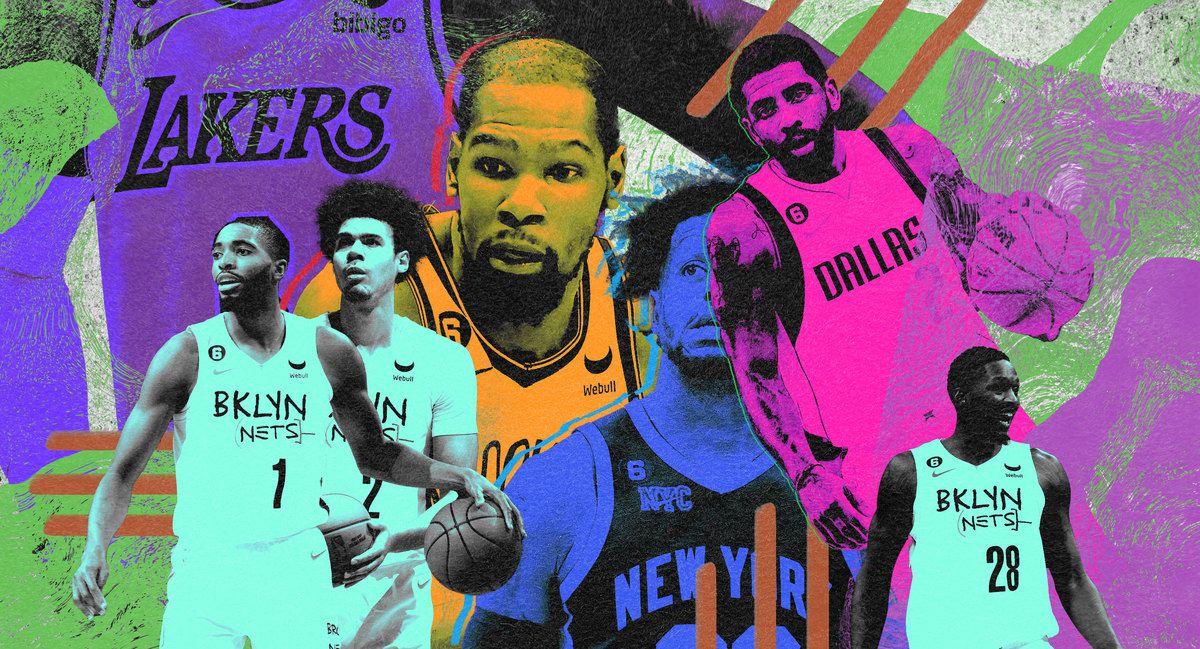Depending on when you catch it, the Anthony Edwards experience is either too much or not enough. Frustrating, tantalizing, and satisfying all in the same game. As an objectively breathtaking 21-year-old with limitless athleticism, this season has provided a flash of budding superstar highs spoiled by streaks of erratic shots and wasteful decisions.
At his most precocious, the explosiveness, aggression, and ability to make impossible shots look routine have coalesced to signal a leap toward becoming the type of showstopper who demands award recognition. But progress is not linear. Misreads are frequent. He’s still prone to shoot over a double-team instead of feed an open teammate. There are dry spells that counteract his volcanic eruptions, and all of it feels less relevant than it should be. Edwards is a peripheral character in an NBA season that intended for him to shine as a central figure. Before it began he was the favorite to win Most Improved Player, on a team with undeniable momentum and lofty playoff aspirations.
Instead, Edwards has encountered natural growing pains while learning to be the team’s primary threat because of the Minnesota Timberwolves’ inconsistent rotation, various injuries (Karl-Anthony Towns has been out since November), and a roster that wasn’t built with Edwards’s development in mind. And still, he’s grabbed the reins and kept his flawed team afloat, averaging 24.5 points, 6.0 rebounds, and 4.5 assists per game, with steel shoulders in transition and an above-average 3-point percentage despite launching some of the most ambitious tries in the league.
Minnesota’s offense functions as the best in basketball when Edwards is on the floor without the team’s nominal point guard, D’Angelo Russell, a free-agent-to-be who’s too shot-happy and defensively inept to coexist long term besides Ant, whose usage rate and true shooting both rise in Russell-less minutes. Lineups that feature him apart from Russell, Towns, and Rudy Gobert are even better.
Last year’s postseason jacked all expectations through the roof (which is really saying something, considering Patrick Beverley told Edwards he could be the next Michael Jordan before the first round even started). In giving the Grizzlies all they could handle, Edwards became the first 20-or-under player in NBA playoff history to average at least 25 points with a true shooting that exceeded 60 percent.
“He’s a special, special, special, special, special player. I’m very, very fortunate to play with him,” Towns said at the time. “I’ll even go as far as saying he’s the most talented player I’ve ever played with.”
After that series, it was easy to envision how Minnesota would blossom in the years to come. But instead of exercising patience, the Wolves attempted costly shortcut by trading Malik Beasley, Beverley, Jarred Vanderbilt, Leandro Bolmaro, rookie rim protector Walker Kessler, and a barrel of draft picks to the Jazz for Gobert, a 30-year-old three-time Defensive Player of the Year whose offensive limitations complicate his value. Instead of setting Edwards (and Towns) up for success, the trade has impelled the Wolves’ young star to navigate a room full of trip wires. Minnesota tried to shore up its defense by skipping steps, which forces Edwards to absorb more offensive responsibilities than ever before.
Things haven’t gone according to plan. The Wolves started 5-8 and were 16-21 on New Year’s Eve. Their offense is below average, they can’t rebound on either end, and for the first time in ages Gobert’s team is better when he’s off the court. In the season’s opening few weeks, Edwards (justifiably) grumbled about narrow driving lanes (more on that later) and his conditioning was (justifiably) called out in public. Then Towns went down in late November and Edwards lost an ideal pick-and-roll partner who’s spent his entire career dragging big men out of the paint. But halfway into a mixed bag of a season, Edwards has settled into a borderline All-Star campaign.
He’s not quite where Ja Morant was in 2022 (in the midst of his own third-year leap or a realistic All-NBA/Most Improved Player candidate), but when you analyze Ant’s production within the context of an environment where his complementary pieces are anything but—it’d be fantastic to have a pass-first point guard who can space the floor and not get bowled over on defense—the question of whether he’ll make multiple All-Star teams can probably be answered in the affirmative. (It was very hard not to pick him this year!)
Instead, it’s more useful to ask what type of force he’ll be; for Edwards to max out his potential and become the chief ball handler on a bona fide contender, he must become the playmaking virtuoso who can set a table and flip it over.
Extrapolate his very best moments and it’s not so hard to envision a hue of James Harden or Luka Doncic, motherboards who roll out of bed knowing they can demobilize any coverage with the same effort it takes to pluck lint from a sweater. A future where Edwards sees every pass, then bends defenses as a constant threat to score from any spot on the court, is a future that 29 NBA organizations are petrified of.
The tools to become an elite offensive engine are visible whenever two defenders come to the ball and Edwards moves it a beat before the defense expects him to, creating an advantage for the other four Wolves. Here’s a perfect example (that becomes less perfect after Gobert flubs the dunk):
Instead of pulling up or trying to turn the corner against a big who’s up, Edwards becomes much harder to stop when he makes reads like this one:
But Edwards also loves to shoot, which may ultimately lead him to become the type of star who scores at will with efficient splits but doesn’t necessarily make life easier for anyone around him. Think Donovan Mitchell or Zach LaVine, hyper-athletic, pyrotechnic scorers who aren’t consistently comfortable balancing their buckets with being a full-time floor general. That version of Edwards may win a scoring title or two, but playoff success would be a different proposition.
Out of the 85 players who’ve run at least 400 pick-and-rolls this season, Edwards has passed the least and shot the most. There’s an antsiness (pun intended) to his shot selection. If an opposing player is in the gap and a teammate is wide open for 3, he’ll sometimes respond with a contested midrange pull up. If his defender ducks under a screen, regardless of time and score, that ball is going in the air. Which is not great considering his pull-up percentages.
Much like the franchise that drafted him, Edwards skips steps, too. There’s not enough patience on these possessions, especially for someone with unparalleled physical gifts who can blast through slits of space with myriad moves—his spin to the left hand is delightful—that can catapult him into the paint.
And with a 3-point rate that’s 11 percentage points lower than last year, Edwards has also developed a pseudo-obsession with the worst shots in basketball. More specifically, he leads the league in 2-point jumpers launched at least 21 feet from the basket, with a toe that’s all too frequently smudging the arc.
Edwards doesn’t need to run 50 pick-and-rolls a game to reach his ceiling. But it’s also easy to rationalize putting the ball in his hands as much as possible, knowing he draws a substantial amount of attention and possesses the physical upside and advanced ball skills very few at his position ever have.
Edwards’s chemistry—or lack thereof—with Gobert is a whole chapter in the book of his own struggles. It can politely be described as a work in progress and accurately dismissed as nonexistent. There are 53 duos who’ve collaborated on at least 350 pick-and-rolls this season. When Edwards and Gobert link up, the Wolves generate a paltry 1.05 points per possession (52nd out of those 55 combinations). More notably: Gobert has taken eight shots all season after he sets a screen for Edwards. Eight! And of those eight shots Gobert has taken, only a few have been clean lob dunks. This is a good encapsulation of how ugly the rest look:
There was one play during Wednesday night’s win against the Pelicans where Jonas Valanciunas, defending a high Edwards-and-Gobert pick-and-roll, scampered up to the screen and left Rudy wide open on a dive to the rim. Edwards saw his open teammate cutting to the rim, and instead opted for a contested 3 that didn’t go in.
This isn’t a crisis quite yet, but is on its way to becoming one. Earlier this year I asked Mike Conley what the biggest difference was between this Jazz offense and the ones he helped shepherd the past few seasons. “The paint’s open.” When Gobert isn’t setting screens on or off the ball, or standing in the dunker’s spot and waiting for a lob, he’s usually ducking into the paint and clogging the lane. Those moments sabotage Edwards.
There are 97 players who’ve driven the ball at least 250 times this season, and Edwards ends just 16.7 percent of them with a pass, which is sixth lowest. At least one help defender is present a whopping 85.7 percent of the time, too.
The spacing issues are real. The Timberwolves make only 11.6 3s per game, which is 18th in the league and a 21.5 percent drop from last season. Towns’s absence has something to do with that. As does Jaylen Nowell shooting 28.5 percent and no other high-volume outside threat playing meaningful minutes on this roster. The floor is particularly cramped when Gobert and Kyle Anderson (who’ve combined to take 53 3s in 2,291 minutes) share the floor.
When Edwards plays without Gobert or Anderson, Minnesota’s offense becomes historically efficient. The general lack of space helps explain why Edwards, whose first step can’t be captured by flash photography, doesn’t glide downhill more often. His 12.06 drives per game are a lot, but also fewer than Fred VanVleet, RJ Barrett, and a whopping 29 others. Bad spacing or not, Edwards accelerates too fast not to be in the paint more often than he is. His dunk rate is at a career-low 4.4 percent, and he didn’t get his first with Gobert on the court until the season’s 12th game.
Edwards’s defense is touch-and-go. In a recent game against the Bucks, he spent a few minutes shadowing Giannis Antetokounmpo up and down the court—a stretch that yielded his most impressive block of the season:
He can be rock solid on the ball, strong and quick enough to hold his ground against multiple positions. He also averages 1.7 steals per game (tied for fifth in the league), which certainly sounds great. But Edwards gets there by gambling way more than Minnesota needs or wants him to:
On the whole, considering the circumstances he’s had to endure and the positive developmental steps he’s made over the past couple months, Edwards’s trajectory remains on a steep incline. He has the potential to be a household name.
In what should still be considered the earlier years of his steady evolution, Edwards’s playmaking instincts could use some work. But his path to becoming a reliable, high-usage conductor is viable, particularly if and when he stops settling and hones a shot selection that, at times, has become his own worst enemy. He’s already shown an ability to get any shot he wants. Once his priorities shift and he’s able to operate in a system that can actually space the floor, Edwards will be unstoppable. In the middle of an understated albeit impressing year three, the only person who can keep him from getting there is himself.

